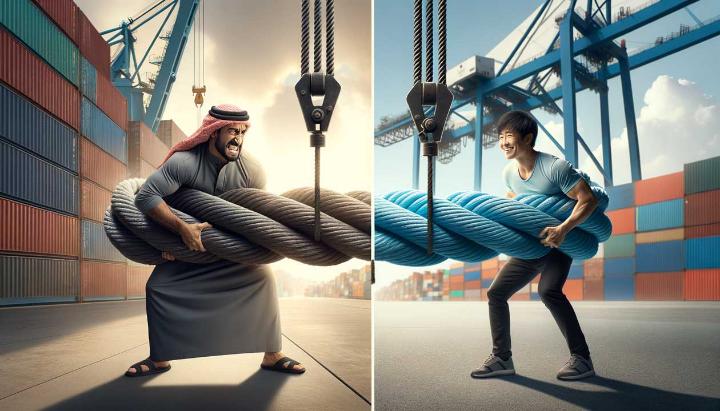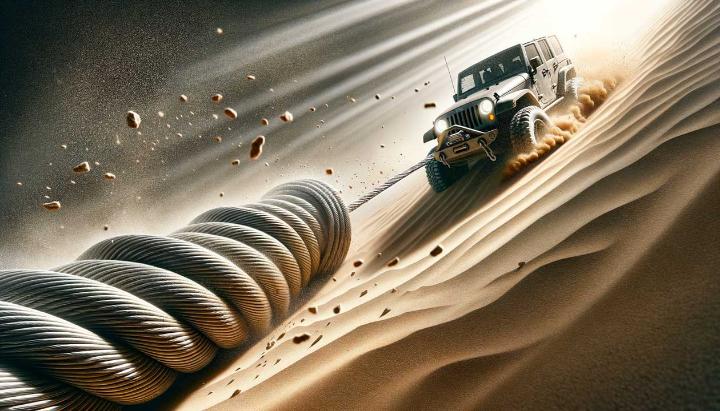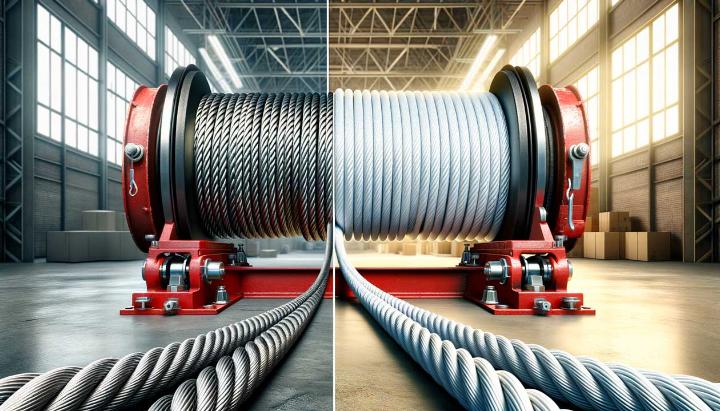Have you ever found yourself in a sticky situation, relying on your trusty winch to pull you out of trouble, only to be let down by a frayed or rusted wire cable? It's a scenario that's all too familiar for off-road enthusiasts and industrial operators alike. But what if there was a solution that could revolutionise the way we think about winching?
Enter UHMWPE ropes - the game-changing alternative to traditional winch wire cables. At iRopes, we've seen firsthand how these ultra-high-molecular-weight polyethylene ropes are transforming the industry, offering unparalleled strength, durability, and versatility that leave steel cables in the dust.
In this post, we'll dive deep into the world of winching technology, comparing the tried-and-true winch wire cable with our cutting-edge UHMWPE ropes. We'll explore why, despite its long-standing popularity, winch wire cable simply can't compete with the numerous advantages offered by UHMWPE. From superior strength-to-weight ratios to enhanced safety features, we'll uncover the compelling reasons why more and more professionals are making the switch.
So, whether you're a seasoned off-road veteran or an industrial operator looking to optimise your winching operations, buckle up. You're about to discover why UHMWPE ropes are not just the future of winching - they're the present. And trust us, once you experience the difference, you'll never look back.
Limitations of Winch Wire Cable
When it comes to winching applications, the choice of cable can make or break your operation. While steel wire rope has been a go-to option for years, it's essential to understand its limitations. Let's dive into why winch wire cable might not be your best bet for heavy-duty winching tasks.
Working Load Limit of Steel Cable
First things first, let's talk about the working load limit (WLL) of steel cable. For a common 5/16" steel cable, the WLL is typically around 2000 pounds. Now, that might sound impressive, but here's the catch: the WLL is significantly lower than the cable's breaking strength, which is about 10,000 pounds for the same size. This difference is crucial for safety reasons, but it also means you're not utilizing the cable's full potential.
Disadvantages of Wire Cable for Winching
- Susceptibility to corrosion and rust: Steel cable's worst enemy is moisture. Over time, exposure to the elements can lead to rust and corrosion, weakening the cable and potentially causing catastrophic failure.
- Potential for kinking and damage: Wire rope is prone to kinking under heavy loads, which can severely compromise its strength and integrity.
- Limited flexibility and maneuverability: The rigid nature of steel cable makes it challenging to work with, especially in tight spaces or when quick adjustments are needed.
- Higher risk of injury: Broken wire strands can create sharp edges, posing a significant safety hazard to operators and bystanders alike.
Steel vs. Synthetic Winch Line Comparison
While steel cable does have its merits, such as durability and abrasion resistance, synthetic winch lines are rapidly gaining popularity. Here's why:
Synthetic Advantage
Synthetic winch lines offer superior strength-to-weight ratio, better flexibility, and enhanced safety features.
Synthetic ropes, particularly those made from UHMWPE (Ultra-High-Molecular-Weight Polyethylene), boast impressive strength while being significantly lighter than steel. They're also less likely to store energy, reducing the risk of dangerous recoil if the line breaks.
Have you ever tried to handle a wet steel cable in freezing conditions? It's not a pleasant experience. Synthetic lines don't retain water, making them much easier to work with in all weather conditions.
In conclusion, while winch wire cable has served us well for many years, its limitations are becoming increasingly apparent in modern winching applications. As we continue to push the boundaries of what's possible in off-road and recovery situations, it's clear that alternatives like UHMWPE ropes are leading the way in performance, safety, and versatility.
Advantages of UHMWPE Ropes for Winch Applications
As an off-road enthusiast who's spent countless hours winching vehicles out of sticky situations, I've had my fair share of experiences with both steel wire cables and UHMWPE ropes. Let me tell you, the difference is night and day. UHMWPE (Ultra-High-Molecular-Weight Polyethylene) ropes have revolutionized the winching game, offering a host of benefits that leave traditional wire rope winch cables in the dust.
Strength-to-Weight Ratio Comparison
The first time I held a UHMWPE rope, I was amazed by its lightness. But don't let that fool you - these ropes pack a serious punch when it comes to strength.
- Incredible strength: UHMWPE ropes boast a breaking strength up to 10 times higher than steel wire rope of the same diameter. This means you can use a thinner, lighter rope without sacrificing pulling power.
- Featherlight construction: Weighing up to 10 times less than their steel counterparts, UHMWPE ropes make handling and storage a breeze. No more backaches from lugging heavy wire cables around!

Safety and Handling Benefits
Remember that time your mate got his hand sliced open by a frayed wire cable? With UHMWPE ropes, those days are over. The safety improvements alone make these synthetic winch lines worth their weight in gold.
- No more metal splinters: UHMWPE ropes don't have sharp edges or broken strands, significantly reducing the risk of injury during handling.
- Enhanced flexibility: These ropes are incredibly pliable, making them easier to manoeuvre around obstacles and less prone to kinking.
- Floats on water: Unlike steel cables that sink, UHMWPE ropes float, making water recovery operations much safer and more efficient.
But it's not just about safety. The handling benefits of UHMWPE ropes are a game-changer for any winching operation. Have you ever tried to coil a wire cable in freezing temperatures? It's like wrestling an angry snake. UHMWPE ropes remain flexible even in extreme cold, making them a joy to work with in any weather condition.
Pro tip: UHMWPE ropes made with Dyneema fibre offer the highest strength-to-weight ratio available, making them the top choice for demanding winching applications.
In conclusion, when it comes to winching, UHMWPE ropes offer a compelling package of strength, safety, and ease of use that traditional wire rope winch cables simply can't match. Whether you're a weekend warrior or a professional recovery operator, making the switch to UHMWPE could be the best decision you make for your winching setup. For those looking to further explore the benefits and features of synthetic winch lines, this comprehensive guide on synthetic winch ropes offers valuable insights.
Durability and Longevity of UHMWPE Ropes
When it comes to winching applications, durability is paramount. That's where UHMWPE ropes truly shine. As someone who's been in the recovery game for over a decade, I've seen firsthand how these synthetic marvels outperform traditional wire ropes in terms of longevity and resilience.
Abrasion Resistance and Wear Characteristics
The secret to UHMWPE's exceptional durability lies in its unique molecular structure. These ropes are composed of ultra-long chains of polyethylene molecules, giving them unparalleled strength and wear resistance. But what does this mean in real-world applications?
- Superior abrasion resistance: UHMWPE ropes can withstand repeated contact with rough surfaces without significant wear, outlasting steel cables in harsh environments.
- Enhanced durability with protective coatings: Many UHMWPE ropes come with urethane coatings or polyester sleeves, further boosting their already impressive abrasion resistance.
- Excellent performance in extreme conditions: From scorching deserts to icy tundras, UHMWPE ropes maintain their integrity where other materials fail.

Lifespan Comparison: UHMWPE vs. Other Rope Materials
Let's put things into perspective. In my years of experience, I've seen UHMWPE ropes outlast their counterparts by a significant margin. Here's a quick comparison:
- UHMWPE ropes: Can last 2-3 times longer than traditional rope materials, with some users reporting up to 5 years of heavy use.
- Steel wire ropes: Typically need replacement every 1-2 years due to corrosion and fatigue.
- Nylon ropes: While durable, they tend to degrade faster under UV exposure, lasting about 2-3 years.
But longevity isn't just about the material. Factors like UV exposure, chemical contact, and usage frequency all play a role. That's why UHMWPE ropes excel in various industries, from marine applications to heavy construction. For an in-depth look at their applications, check out our Essential Guide to UHMWPE Mooring Rope.
Did you know? The tensile strength of UHMWPE fibres can last up to 36 years under optimal conditions. That's longer than many of us have been in the winching business!
In the long run, investing in UHMWPE ropes isn't just about superior performance – it's a cost-effective choice. Fewer replacements mean less downtime and lower overall expenses. So, next time you're in the market for a winch rope, consider the long-term benefits of UHMWPE. Your future self (and wallet) will thank you.
UHMWPE Ropes: Versatility and Customization Options
As a rope specialist with over a decade of experience, I've seen firsthand how UHMWPE (Ultra-High Molecular Weight Polyethylene) ropes have revolutionized the winching industry. These remarkable ropes, often known by the brand name Dyneema, offer unparalleled versatility and customization options that leave traditional wire ropes in the dust.
Key Features of UHMWPE Rope
Before we dive into the customization options, let's take a moment to appreciate the incredible properties of UHMWPE rope:
- Unmatched strength-to-weight ratio: UHMWPE is 15 times stronger than steel by weight, allowing for thinner, lighter ropes without sacrificing pulling power.
- Exceptional durability: These ropes boast high abrasion resistance and can withstand harsh environments, from scorching deserts to icy tundras.
- Low elongation: Unlike nylon ropes, UHMWPE ropes have minimal stretch, ensuring precise control during winching operations.
- Non-rotational properties: Say goodbye to those frustrating twists and turns – UHMWPE ropes maintain their shape under load.

Customization Options for UHMWPE Ropes
One of the most exciting aspects of UHMWPE ropes is their incredible adaptability. Here's how you can tailor these ropes to your specific needs:
- Fittings and attachments: Choose from a wide range of end fittings like thimbled eyes, spliced loops, or custom hooks to suit your winching setup.
- Size and diameter options: Whether you need a slim 6mm line for lightweight applications or a beefy 28mm rope for heavy-duty winching, UHMWPE has you covered.
- Color customization: Enhance visibility and brand recognition with custom colors. I once worked with a rescue team that used bright orange UHMWPE ropes – they were impossible to miss in emergency situations.
- Specialized coatings: Add UV protection, improve abrasion resistance, or enhance grip with tailored coatings.
Remember, the right customization can significantly impact performance. For instance, I once helped a mining company switch to a larger diameter UHMWPE rope with a specialized abrasion-resistant coating. The result? They doubled their winch line's lifespan in those harsh conditions. For more on custom options, our customization guide offers vital tips for creating the perfect rope for your needs.
Applications and Versatility of UHMWPE Ropes
The versatility of UHMWPE ropes never ceases to amaze me. Here's a glimpse into their wide-ranging applications:
- Marine industries: From mooring mega-yachts to towing offshore platforms, UHMWPE ropes excel in maritime environments.
- Industrial settings: These ropes are a game-changer in construction, mining, and oil & gas operations, offering unmatched strength and safety.
- Outdoor recreation: Rock climbers and off-road enthusiasts alike swear by the lightweight strength of UHMWPE ropes.
- Specialized fields: I've even seen these ropes used in aerospace applications and cutting-edge robotics projects!
Pro tip: When choosing a UHMWPE rope for your winch, consider the specific demands of your environment. A rope that's perfect for marine use might not be ideal for dusty desert conditions.
In conclusion, the versatility and customization options of UHMWPE ropes make them the superior choice for modern winching applications. Whether you're tackling tough industrial jobs or embarking on extreme outdoor adventures, there's a UHMWPE rope solution tailored to your needs. Isn't it time you experienced the difference for yourself?
Upgrade Your Winching Game with UHMWPE Ropes
When comparing winch wire cable and steel wire rope winch cables to UHMWPE ropes, the latter stands out for its superior strength-to-weight ratio, impressive flexibility, and exceptional durability. Unlike conventional winch wire, UHMWPE ropes offer excellent resistance to corrosion, chemicals, and UV radiation, enhancing performance in various winching applications. Additionally, UHMWPE ropes are safer to handle, reducing the risk of injury from broken strands. For those looking for cost-effective, long-term solutions with minimal maintenance, UHMWPE ropes are the clear choice. Don't hesitate to fill in the form above to explore customised UHMWPE rope solutions tailored to your needs.